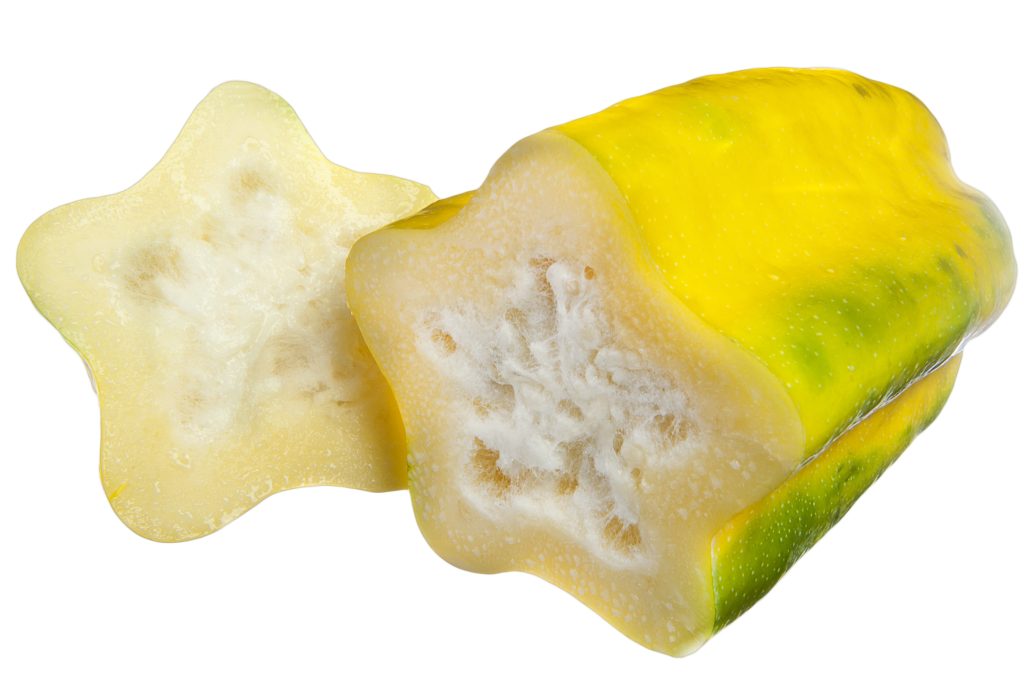Babaco is a tropical fruit that resembles a pear in texture and has creamy, white flesh with yellowish-green skin. This fruit is renowned for its distinct flavor combining papaya, strawberry, pineapple, and kiwi tastes.
Table of Contents
What is a Babaco?
Babaco fruit (Vasconcellea x heilbornii) is common in Ecuador and Colombia in the Andean area of Central America. It is often referred to as champagne fruit or mountain papaya. The papaya fruit and the babaco are linked and are members of the Caricaceae family.
Unlike papaya, babaco is smaller and has a pentagonal shape. Its smooth, light green skin is similar in appearance to that of a giant cucumber. The fruit thrives in subtropical climates and humid weather, and cannot tolerate dry conditions and strong winds. They grow in clusters on small palm tree-like shrubs.
The fruit has a mild flavor and an aroma with traces of pineapple, strawberry, kiwi, and lemon. They’re seedless with yellowish-green, juicy, and sweet flesh. It has good fiber, few calories, vitamins, and minerals. It contains papain enzyme, but it’s not acidic.
The fruit can grow up to 15 cm (5.9 in) wide and 30 cm (11.8 in) long. Babaco plants have few branches and can reach 5–8 m tall. The plants can produce fruits for up to eight years. A mature fruit tree can produce 38 to 100 fruits per year.
The History of Babaco
Babaco fruit is a native of the Central American Andean valleys in the Ecuadorian Andes. It is thought that the ancient Incas cultivated it. Since then, it has expanded to several locations throughout the globe, among them being New Zealand, where it was introduced in 1870.
Currently, New Zealand is one of the largest exporters of this fruit. Its distinctive flavor and adaptability in cooking account for its prominence in international trade.
This exotic fruit is utilized in traditional medicine in several cultures and offers therapeutic benefits in addition to its gastronomic value.

What Does a Babaco Taste Like?
It tastes sweet and tart and has a slightly creamy texture when consumed raw. The flesh is luscious and tender, much like ripe papaya.
The flavor becomes milder and more subtle when cooked, making it suitable for use in foods such as stews, jams, and baked goods.
How to Tell When Babaco is Ripe
Here are tips to help determine if your babaco is ripe.
| Texture | A ripe fruit has a soft, slightly mushy texture and a grainy mouthfeel. |
| Firmness | Like a mature avocado, ripe mountain papaya feels solid but yields slightly when lightly squeezed. |
| Scent | A mature fruit smells sweet, tropical, and somewhat musky, with papaya and pineapple hints. |
| Smoothness/Roughness | The skin of mature fruit is smooth, firm, and blemish-free. |
| Color | The typical color of ripe fruit is yellow or golden with a little greenish tint, and it may have brown patches. |
Choose fruits that are firm, heavy for their size, and have smooth, unblemished skin. Avoid fruits that have soft spots, wrinkled skin, or bruises, as these indicate damage or overripeness.
Additionally, check the fruit’s stem end to ensure it is dry and mold-free, which can signify spoilage.
Is Babaco The Same As Star Fruit?


Star fruit and babaco may have a similar appearance but are different fruits with unique flavors, textures, and nutritional profiles.
Babaco is a variety of papaya with a gentle, creamy flavor with hints of pineapple and strawberry. It contains a lot of fiber, potassium, and vitamin C.
On the other hand, star fruit has a crisp texture and a sour and sweet flavor. It’s a good source of antioxidants and vitamin C.
Cooking with Babaco
Prepare your fruit by washing them under running water to remove dirt. Use a vegetable peeler or a paring knife to peel it off and cut it into pieces.

Some of the most popular dishes that use babaco include:
Babaco Chutney: This fruit-based preserve can be used as a condiment for curries, cheeses, and meats.
Babaco Syrup: This can be used as an ice cream topping. It can also be served as a dessert after a meal.
How to Store Babaco
When you purchase babaco that hasn’t fully ripened, you can leave it on the counter until it turns yellow. Ripening happens rapidly at room temperature, but you may hasten the process by storing the fruit in a paper bag.
You can keep it in a cold, dry area if you don’t want it to ripen immediately. The fruits last almost four weeks when kept in cold, dry areas.
Consuming the fruit as soon as it is fully ripe is ideal. If not, you can store it in the fridge for an extra two or three days.
Nutritional Benefits of Babaco
It’s best to consume babaco uncooked. It is regarded as a superior vitamin C and A source and has three times as much papain as papaya. The fruit is also rich in fiber as well as potassium.
Vitamin C is necessary for our bodies since it promotes wound healing and maintains healthy gums. Fibre regulates and keeps the body’s sugar levels in check.
Potassium keeps the heartbeat in check, ensures the proper function of nerves and muscles, and is crucial in metabolizing carbohydrates and synthesizing proteins.
Where to Purchase Babaco
These exotic fruit starts to ripen around November and continues until June. Babaco fruit’s prime season is in the springtime. If you live near or where the fruits are grown, like Florida or California, you can find the fruits at local markets or the produce section of your grocery store.
You can purchase it from online stores if your local market or grocery store doesn’t carry it.

